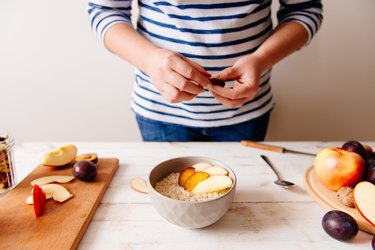
Even if you don't have diabetes, you can still develop hypoglycemia, or low blood sugar. The type of hypoglycemia that occurs in people without diabetes is referred to as reactive hypoglycemia, and it often occurs within four hours after a meal, according to the Mayo Clinic.
The signs of low blood sugar — usually defined as below 70 mg/dL, according to the American Diabetes Association (ADA) — include dizziness, light-headedness, fatigue, hunger and confusion.
Video of the Day
Video of the Day
For people who develop reactive hypoglycemia, "generally what happens is that they eat a food that is rich in simple sugars," says Erin Palinski-Wade, RD, CDE, author of 2-Day Diabetes Diet. "Their blood sugar will go up a bit, but then it drops dramatically, which gives them that feeling of shakiness, light-headedness and feeling like they are going to pass out."
Often, reactive hypoglycemia causes aren't clear, according to the Mayo Clinic, but excessive alcohol consumption, certain health conditions and medications, tumors and surgical procedures (such as a gastric bypass), may play a role.
Hypoglycemia can also occur if you go too long without eating — for example, if you skip meals or are fasting. This type of hypoglycemia doesn't usually require medical attention, according to the Mayo Clinic. If instances of hypoglycemia are recurring, however, reach out to your doctor, since it could be a side effect of a medication or a symptom of an underlying condition that may need treatment, such as a tumor, hormone deficiency or hepatitis.
While there's no such thing as a hypoglycemia diet, there are some steps you can take to prevent reactive hypoglycemia.
Have Small and Frequent Meals
"The best rule of thumb is to really limit simple sugars in the diet," says Palinski-Wade, "but if you are going to have them, have them in small amounts and combine them with foods that slow digestion — something like fiber or fat or protein."
For example, instead of eating three large meals, split your food intake into five to six smaller meals. This will prevent your blood sugars from dipping too low in the hours after a meal, thereby warding off a hypoglycemic episode, according to the Mayo Clinic.
Just don't overdo it on the calories. For example, if your lunch usually is a sandwich, an apple and a yogurt, divide your meal into two parts. Have the sandwich first, then eat the apple and yogurt a few hours later.
Read more: How to Eat 6 Times a Day and Lose Weight
Choose Low-Glycemic Index Carbohydrates
Eating carbohydrate-containing foods with a high glycemic index can make your blood sugar peak higher, which overstimulates the secretion of insulin and may result in reactive hypoglycemia within a few hours.
When possible, avoid highly processed, refined breads, cereals, crackers and desserts — and replace them with lower-glycemic index carbs, like whole grains, that can help you stabilize your blood sugar levels. Smart choices include vegetables, some fruits, chickpeas, lentils and high-fiber, low-sugar breakfast cereals, according to the Mayo Clinic.
Read more: Everything You Need to Know About Carbs
Complete Your Meals With Protein
Try not to eat carbohydrates alone. Protein helps to keep your blood sugar more stable after eating, so include a source of protein at each of your small meals and snacks. Smart options include cheese, eggs, chicken, fish, meat, tofu, legumes, nuts, nut butter and seeds.
Add Soluble Fiber
Soluble fiber can help even out your glycemic response after a meal. That's because soluble fiber absorbs water and slows down the absorption of sugar, which can help control blood sugar levels.
You can find soluble fiber in foods like ground flaxseeds, oats, eggplant, okra, apples and oranges. Add them to some of your meals and make sure you drink plenty of water to help soluble fiber work more effectively.
Was this article helpful?
150 Characters Max
0/150
Thank you for sharing!
Thank you for your feedback!